The Gang Back at Home
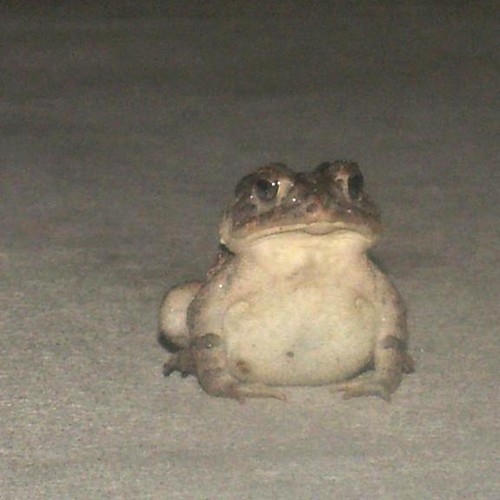
Why settle for toad flax when you can have the toad?....
Mary and I had started our walk home from the supermarket at close to 9 PM. The sky had been cloudy while we were inside; now we were in fine drizzle blown sideways by the wind. Without any umbrellas, we would stay under the strip mall's awning for as long as we could.
This little one had the same idea but didn't seem in any hurry to go anywhere. Mary saw the toad first. She stopped, pointed. I'd been holding my camera bag close to my side against the elements. Now I whipped out the camera and flipped up the flash.
Getting my lens to focus was another matter; there was so little light to go by. I fiddled with manual controls, with telephoto. I photographed a lamp just to be sure my shutter release worked -- before I learned that if I held the button down long enough my camera would sigh and say, "Oh, all right! But you won't like it." Finally it relented and focused for a 1/40-second exposure at f/3.2.
I think this is a Southern Toad (Bufo terrestris). It seemed unperturbed as I dropped to the sidewalk and lay on my stomach a few feet off, clicking away. According to the National Audubon Society Field Guide to Florida, this 3-inch, nocturnal toad lives mostly in sandy pine and oak woods, a habitat that matches this area where it isn't developed.
Everything around here is leafing out gangbusters and the air is beginning to buzz again with pollinators. Mary has standing instructions that, regardless of how much or how little sleep I may have gotten (since sometimes I work through the night), she is to wake me up if she's up first and sees hummingbirds sampling our honeysuckle. They haven't shown up yet, but last year we saw them the beginning of April.
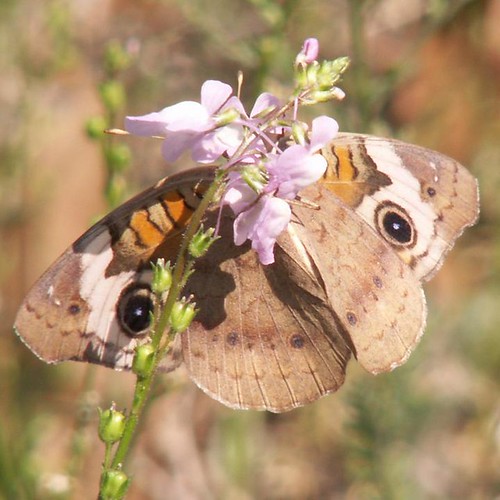
Common Buckeye, Junonia (Precis) coenia, Brushfoot Family. I spotted two of them in our front yard when I headed out for my post office walk. They were enjoying our toad flax immensely.
According to our Audubon Field Guide to Insects and Spiders, the buckeye caterpillar eats snapdragon (which this toad flax is), monkey flower, plantain, stonecrop, and other low herbs. "The Buckeye flies swiftly if disturbed. Males dash after others of their own and different species and even chase Carolina Locusts."
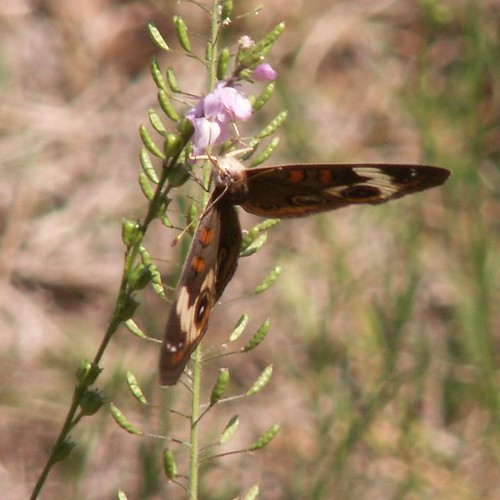
This one, head-on, shows its proboscis. Another shot of a buckeye, taken last year, is here.
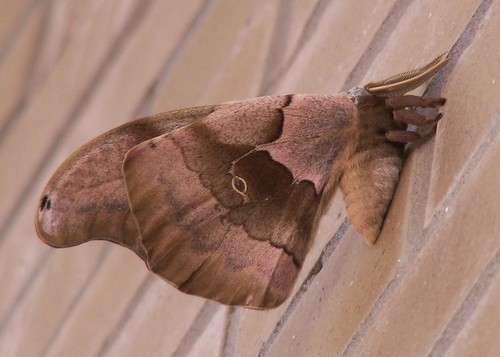
Polyphemus moth (Antheraea polyphemus, Giant Silk Worm Family). At first I thought I saw a leaf stuck onto the brick wall outside the bank. A hefty breeze was blowing it off to the side. As I got closer I realized what I was looking at.
This moth's wingspan is around 5-6 inches. Its season is from February to July and October to December. (The one I photographed outside the supermarket last year had appeared in October.)
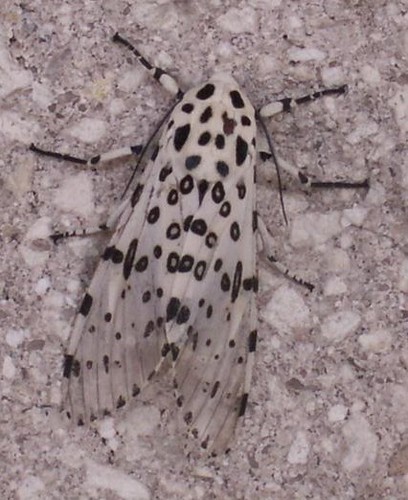
Giant Leopard Moth (Hypercompe scribonia, reclassified from Ecpantheria; Tiger Moth Family (Arctiidae), subfamily Arctiinae). Found outside the supermarket.
From Steven H. Long at Clemson University:
"This moth can be found throughout the southeastern United States ranging from New England to Mexico. The immature stage of this moth is a caterpillar, known as the woolly bear caterpillar because it is heavily coated with long black hairs, known as setae. When feeling threatened, the caterpillar will curl up in a ball revealing bright red markings between its many segments. They feed on almost any type of foliage, but only for a brief time before spinning a cocoon and emerging a few weeks later as a mature moth.
"The moth stage of this species is very beautiful. The wings of the moth are solid white, with irregularly shaped black circles all over them giving it the leopard-like appearance. The abdomen is dark blue with orange markings. After emerging from the cocoon, the male species of moth immediately begins its search for a female to mate with. The female moth releases a pheromone into the air for the male moth to find and locate her by. The male will pick up the smell and fly in a zigzag pattern into the wind until he reaches his female and mates with her. After mating has taken place, the male goes out in search of another female while the female he has mated with begins dispersing her fertilized eggs wherever she may find."
This moth was kind enough to hold its pose long enough for me to take a 3D stereogram. (In fact, it held the same pose all the time it took me to get to the post office and back.) I had seen the Buckeyes, Polyphemus, and Giant Leopard all on the same walk.
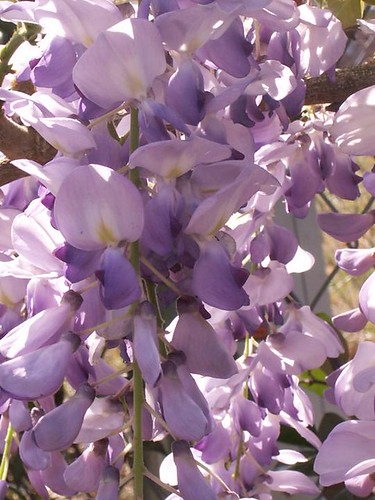
Thanks to Mary, who finally saw this hanging off our neighbor's fence in daylight, for identifying the plant as wisteria. At first I'd wondered if it were a lilac (based on its color and heady fragrance; but the petal structure is different). Then I thought it might be coastal plain lobelia (based on our field guide).
For a while I didn't know whether this was a Chinese (Wisteria sinensis) or American (Wisteria frutescens) variety. Both are in the Leguminosae/Fabaceae (bean) Family. Then I learned that American wisteria flowers have no fragrance -- at least according to Will Cook at Duke University. Floridata.com disagrees, but I suspect this plant is Chinese wisteria.
According to Floridata.com, the Chinese wisteria "thrives so well in Florida it has earned a place on the state's invasive species list but is less aggressive in colder climates."
The site adds, "A better choice for Florida gardens is the native American wisteria, which is also beautiful and fragrant [here disagreeing with Cook] but more compact and less aggressive." The site warns, "Chinese wisteria is a Category II plant on the Florida Exotic Pest Plant Council 2001 List of Invasive Species. This category consists of exotics that have increased in abundance or frequency but have not yet altered Florida plant communities to the extent shown by Category I species. These species may become ranked Category I, if ecological damage is demonstrated. This vigorously growing vine may be troublesome in similar mild winter areas as well."
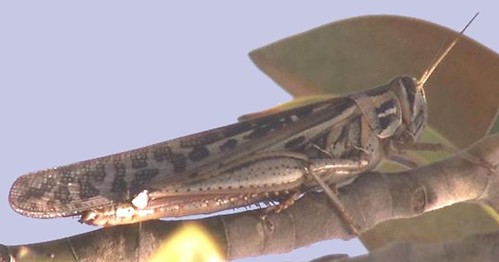
American Bird Grasshopper (Schistocerca americana, also called the American Locust). This little one had flown into a magnolia tree as I approached. The shot is rotated 90 degrees to the right.
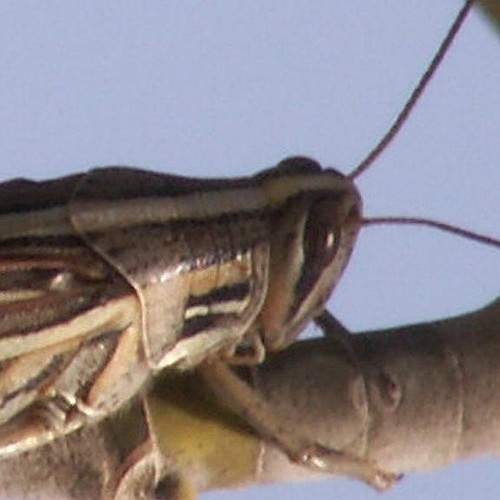
According to Patrick Coin, writing in the New Hope Audubon Society Newsletter (.pdf file), this grasshopper "occurs throughout eastern and central North America. It is somewhat migratory, ranging northward in summer to Canada. The closely related Desert Locust of the Old World, Schistocerca gregaria, is famous for forming migratory swarms and destroying crops. The American Bird Grasshopper is said to form damaging swarms on occasion, though I have not seen it in plague proportions in our area. It feeds on a wide range of vegetation, including crops, grasses, forbs, and the foliage of woody plants." Coin adds that this species "has the peculiar habit of flying up into trees when disturbed, a habit unique to this genus."
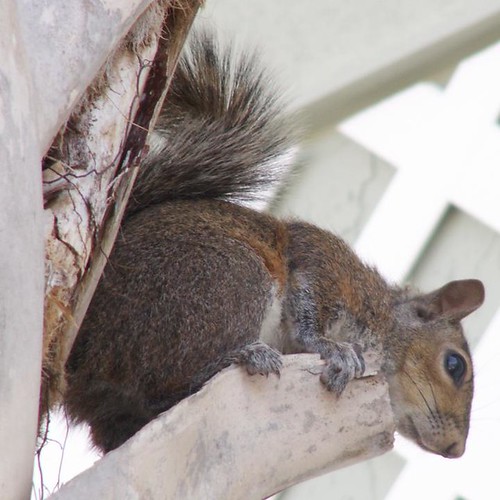
Taken outside a new apartment complex in the area. According to the University of Michigan Museum of Zoology (whose page is chock full of information), this Eastern Gray Squirrel (Sciurus carolinensis, Family Sciuridae) "ranges over the eastern United States to just west of the Mississippi River and north to Canada. Introductions have occurred in the western states and some of Canada that was not previously inhabited, as well as in Italy, Scotland, England and Ireland."
U MI continues, "A dominance hierarchy forms in males during breeding times; females mate with several males. Related individuals may defend a territory (Taylor 1969). Squirrels occupy two types of homes, including a permanent tree den as well as a nest of leaves and twigs on a tree crotch 30-45 feet above the ground. Females nest alone when pregnant, and lactating females are especially aggressive and avoided by others (Ruff and Wilson, 1999)."
These squirrels can live up to 12.5 years in the wild. A captive female lived for more than 20 years.
I've picked up framed photos for display at the art league gallery next month (a first for me, at least insofar as photos are concerned), including one that I'll be entering in the next camera club competition. As I drafted this entry, Mary brought me an interesting-looking, roughly quarter-inch-long, dead bug she'd found on the kitchen floor. We've since identified it as a kind of earwig -- though there are so many types I haven't yet identified the family, let alone the species or genus. She had coaxed the corpse upright inside a dainty little china bowl so that I could photograph it.
That one's not apt to become a gallery picture.











3 Comments:
Chronicles of the world we share... your photographs, detailed descriptions with scientific names, narratorial voice with you hovering behind the camera who we can imagine if not see, yours and Mary's wonderful relationship as another backdrop are, oh there are no words. Wonderful, refreshing, informative, feast for the eyes, rich, depth-full.
I noticed the peepers screetching yesterday for the first time...and watched a squirrel eating a nut for 5 full minutes today. I wanted to photograph him but he was so camoflaged with the scenery, I knew it wouldn't translate.
I love the blog! Unfortunately it will take me a long time to get through your back collection, but I will keep coming back.
About the polyphemus: if you poke the abdomen with your finger (to let them know you see them), they will spread their wings and show you their eyespots: http://photos1.blogger.com/blogger/5393/1168/1600/321poly1.jpg
Post a Comment
<< Home